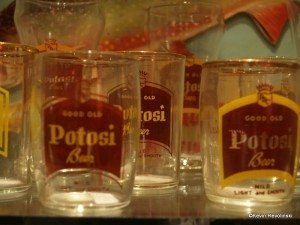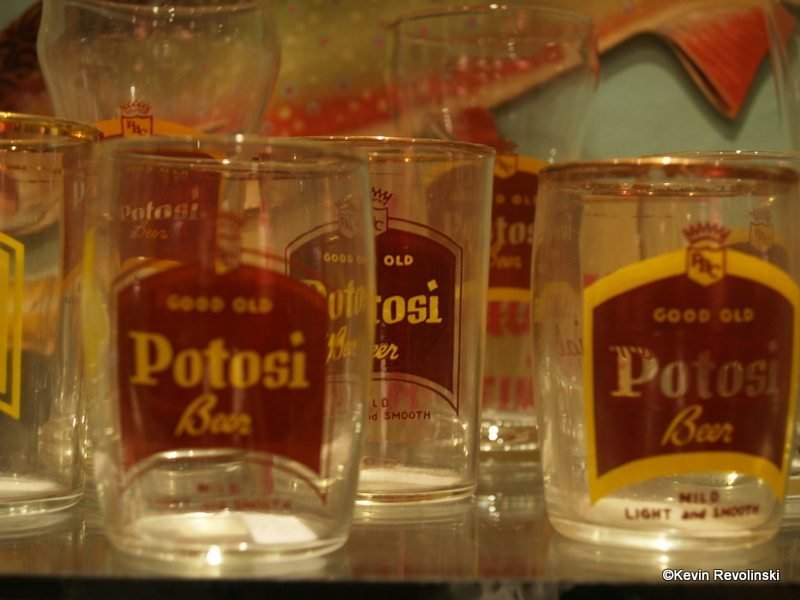Beer Shrine Puts Little Potosi, Wis. on the Tourism Map
 Like any good Wisconsin boy, I collected beer cans when I was young. It was a veritable rite of passage to acquire all the Schmidt cans with their varying pictures, and you were a hero in my neighborhood if you found one of the old bottle-can hybrids known as a cone-top. So when I heard about the National Brewery Museum and its collection of beer memorabilia (known as breweriana), I felt a nostalgic urge to get in my car right away and drive straight to… Milwaukee? Nope. St. Louis then? No way. If you guessed Potosi, Wis., you either live there or are out of your mind.
Like any good Wisconsin boy, I collected beer cans when I was young. It was a veritable rite of passage to acquire all the Schmidt cans with their varying pictures, and you were a hero in my neighborhood if you found one of the old bottle-can hybrids known as a cone-top. So when I heard about the National Brewery Museum and its collection of beer memorabilia (known as breweriana), I felt a nostalgic urge to get in my car right away and drive straight to… Milwaukee? Nope. St. Louis then? No way. If you guessed Potosi, Wis., you either live there or are out of your mind.
But indeed, Potosi it is, where seven-eleven is not a convenience store but rather the population number on the sign at the edge of town. And now it’s the home of a $7 million project in a restored 1852 brewery building that includes a restaurant, microbrewery and an unrivaled exhibit of often rare collectibles from the history of
brewing in America. As if the World’s Largest Cone-top Beer Can weren’t reason enough to visit Potosi.
 I follow my urge and drive to the southwest corner of Wisconsin to the banks of the Mississippi along the Great River Road. At the edge of town is a four-story brick building tucked into a bluff. The grand opening is 4th of July weekend, but Potosi isn’t hung up on big-city official hours.
I follow my urge and drive to the southwest corner of Wisconsin to the banks of the Mississippi along the Great River Road. At the edge of town is a four-story brick building tucked into a bluff. The grand opening is 4th of July weekend, but Potosi isn’t hung up on big-city official hours.
Frank Fiorenza, the village president and a board member of the Potosi Brewery Foundation, is my guide. He walks me through as he’s been doing for anyone who has randomly stopped by in these last few weeks, and I witness the finishing touches being put on. His excitement is palpable; he seems almost unsure of what to show me first. “This has far exceeded my expectations,” Fiorenza said.
Mine too. Don’t think that this is a kitschy basement full of beer signs and a cupboard of mismatched beer glasses. Fiorenza shows me a vintage Pabst lithograph print. “This is worth $15,000,” he tells me. Rare character steins from the 1920s and ’30s—even some of Mickey Mouse and Donald Duck—surprise me as well.
Fiorenza points out the abundance of children in brewery ads along the walls, picnic scenes from a day when a beer apparently was a family event. “You wouldn’t see that today,” he adds.
Find the museum in my book Wisconsin’s Best Beer Guide
Tap handles, serving trays, clocks, calendars, posters and even oil paintings fill the rooms. A couple large-screen TVs show vintage beer commercials and documentaries about the brewing process. Another room
holds a research library. “In the 1880s, there were over 2,400 breweries in the United States,” Fiorenza says. “The library has information on nearly all of them that ever existed. If someone comes here from Montana or Kentucky and they want to find information on the brewery from their hometown, all of the items
would be on the computer.”
 On the ground floor is a transportation museum and an interactive interpretive center for Wisconsin’s segment of the Great River Road Scenic Byway. An old lagering cave is viewable behind a glass wall, and a gift shop offers all sorts of Wisconsin paraphernalia and a selection of locally produced cheeses, wines, syrup, honey and beer.
On the ground floor is a transportation museum and an interactive interpretive center for Wisconsin’s segment of the Great River Road Scenic Byway. An old lagering cave is viewable behind a glass wall, and a gift shop offers all sorts of Wisconsin paraphernalia and a selection of locally produced cheeses, wines, syrup, honey and beer.
As impressive as this place is, it still begs the question: Why here? The American Breweriana Association had been mulling over making a museum for their members to showcase their collections. In 2003 when the association held its annual meeting in Stevens Point, Wis., a delegation from Potosi attended to make their case alongside hopeful hosts from brewing Meccas Milwaukee and St. Louis. Fiorenza acknowledges that there were doubters, but as he points out, it’s more centrally located for large population centers. Besides, Potosi
had a historic brewery—and a plan to restore it.
When the deciding association members, including the president, Len Chylack, came to town in June 2004, the Potosi Brewery, which had closed its doors in 1972, had trees growing through the roof. But remarkably, after meeting with the Potosi Brewery Foundation in the new local firehouse, the association members came back with a yea vote for Potosi.
When Fiorenza asked what the deciding factor was, Chylack told him, “This building. If this community can provide a facility like this for their volunteer fire department and rescue squad, I believe you can redo [the old brewery].”
The partnership agreement between the foundation and the association was signed in August 2004.
 But what’s a brewery museum without beer? Steve Zuidema has been brewing for 17 years and got his start when he opened his own microbrewery, Front Street Brewery in Davenport, Iowa. He commutes to Potosi each week to make beer flow once again. The brews are ales—faster to ferment—and will include approximations of the traditional Potosi brews—Good Old Potosi and Holiday Bock—and a few others: Potosi Pure Malt Cave Ale, Snake Hollow IPA and Potosi Steamer Hefe Weiss. The Potosi Brewery also will make
But what’s a brewery museum without beer? Steve Zuidema has been brewing for 17 years and got his start when he opened his own microbrewery, Front Street Brewery in Davenport, Iowa. He commutes to Potosi each week to make beer flow once again. The brews are ales—faster to ferment—and will include approximations of the traditional Potosi brews—Good Old Potosi and Holiday Bock—and a few others: Potosi Pure Malt Cave Ale, Snake Hollow IPA and Potosi Steamer Hefe Weiss. The Potosi Brewery also will make
its own root beer.
Besides being poured at the bar, Potosi beer will be sold in 22-ounce bottles, half-gallon “growlers” and kegs. Zuidema estimates he will produce 1,500 to 2,000 barrels per year, certainly less than the 65,000 churned out by the New Glarus Brewing Co. but more than many Wisconsin brew pubs. Plans include regional distribution, and licenses are being pursued in Illinois and Iowa.
In making beer, the quality is, of course, in the ingredients, and the first matter is the water. Many of the breweries of old were built around or on top of artesian wells and natural springs. Potosi is no exception. The water still rushes out of the ground into the old brewery pond behind the new beer garden. The flow is so
overwhelming that years ago it would get into the brew- house and collect in puddles on the floor. Remodeling included an overflow pipe that diverts some of the spring water, and as I walk through the restaurant, I can see it rushing beneath a piece of Plexiglas in the floor.
 I watch as Potosians Gary David, his son, Tyler, and his father, Marvin—three generations of woodworkers—do the final assembly of the restaurant’s beautiful handcrafted bar. The tables around the room are made with the cypress of the old fermentation tanks.
I watch as Potosians Gary David, his son, Tyler, and his father, Marvin—three generations of woodworkers—do the final assembly of the restaurant’s beautiful handcrafted bar. The tables around the room are made with the cypress of the old fermentation tanks.
The restaurant is set to come online even before the grand opening. Jason Culbertson, the head chef, is a graduate of Le Cordon Bleu College of Culinary Arts in Minneapolis. He tells me, “The menu is upscale casual; gourmet sandwiches and burgers.” And beer will be part of the cookbook: Ribs will be beer-braised, and the beer and cheese soup, a Wisconsin institution, will use Culbertson’s own recipe combining bock beer, smoked Gouda and roasted red peppers.
But the vision of this village goes beyond the museum. The new Holiday Gardens is an event center on the site of the former brewery farm across the street. Fiorenza sees the resurrected brewery complex as part of a regional experience that also includes wildlife preserves, an old lead mine-cum-museum and the scenic drive along the Mississippi.
The museum management expects that 30,000 to 40,000 visitors each year will agree that Potosi is more than worth the drive. And that begs one final question. As the brewery ad once asked, “Have you had your Good Old Potosi today?”



 ORDER YOUR COPY TODAY!
ORDER YOUR COPY TODAY! ORDER YOUR COPY TODAY!
ORDER YOUR COPY TODAY!